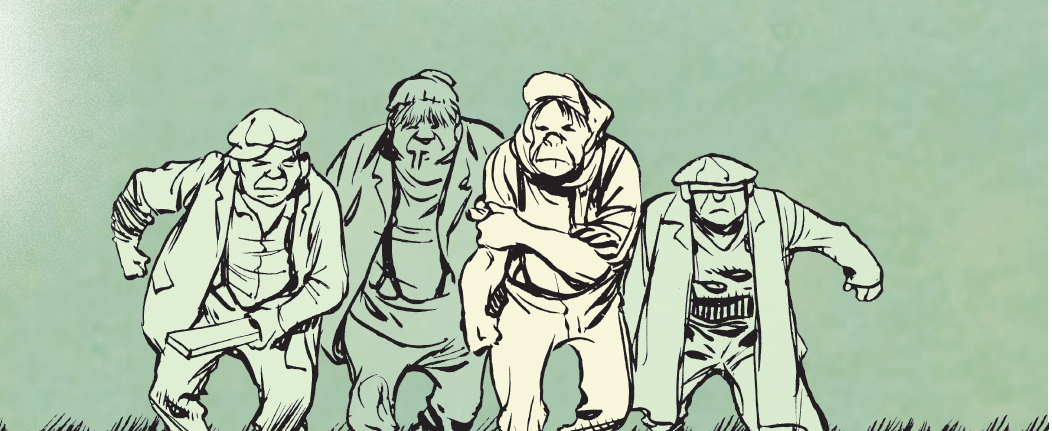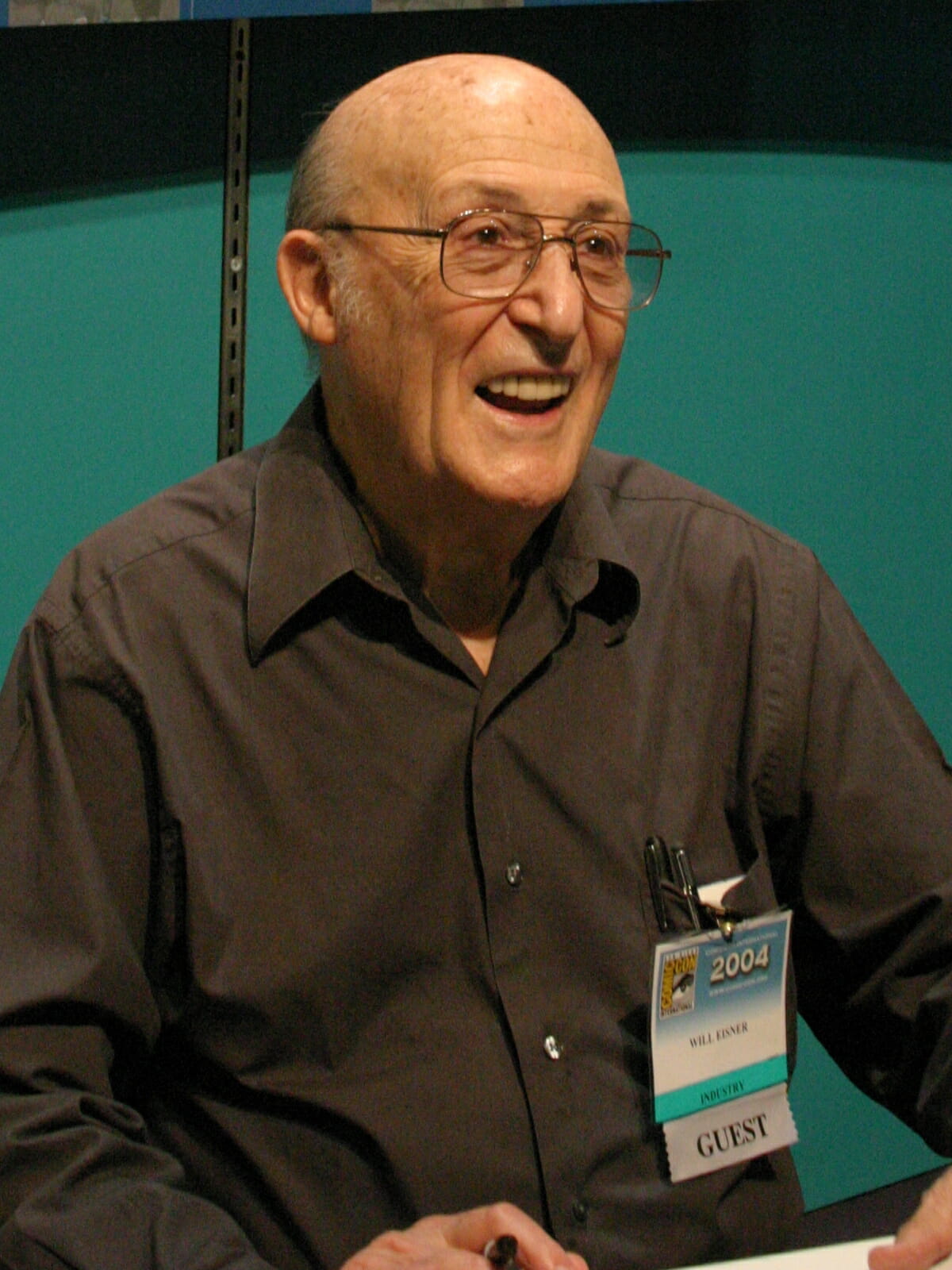
There are three ideas that encompass the latest works of American cartoonist Will Eisner (1917-2005), a cornerstone of contemporary comics. They are: the meaning of human life; the lifespan of a city area; and the impact the previous two have on people’s existence. Especially within the trilogy of The Contract with God (1978), these three themes are the main focus. From short stories to a neighborhood history throughout an entire century, these comics rely on a low concept format, with common people as protagonists as shown also by the other graphic novels of the trilogy, A Life Force (1988) and Dropsie Avenue (1995).
The meaning of life and the struggle with God
A Contract with God, eponymous of the whole trilogy, gives center stage to the question about the meaning of life and the role God plays in it. After suffering the death of his daughter, the devout Frimm Hersch turns into a cynic and greedy man. His contract with God ended. Living following morals and altruistic principles has no significance if the reward is losing what you care about the most. However, the sense of what happens throughout life cannot be reduced to a list of rules. The fact is symbolized by Hersch’s death right after he signs a new contract.


The conundrum of mankind’s existence is inextricable, as the protagonist of A Life Force, Jacob Shtarkah, points out too:
If man created God, then the reason for life is only in the hand of man! If, on the other hand, God created man, then the reason for living is still a guess! After all is said and done… who really knows the will of God?
A (non) pessimistic perspective
Eisner’s stories are bittersweet, lacking easy happy-endings, and yet they show it is worth living. A Life Force carries out a parallelism between humans and cockroaches. Be it a curse or a blessing, they both keep on surviving. However, even if Eisner highlights the admirable will to live of these bugs, he wants to show that mankind’s existence is more than mere survival. Even when it seems meaningless, unsatisfying, or painful, everyone’s story contains valuable experiences.
Apparently pessimistic, Eisner wants instead to say that one can be happy, but without forgetting about the inevitable pain life entails. After suffering a severe disappointment work-wise, Jacob gets the chance to start again and live a dreamy love story. It doesn’t end like he wanted, leaving him with just a feeble possibility. And, as he says to himself, “I suppose it is more than a cockroach has!”.


The story of a neighborhood…
The said value one gives to their own life depends also on where they grow up and live. And among the many characters, one of the protagonists of Eisner’s stories is for sure the Bronx neighborhood, where he grew up. Like in David Lynch’s Twin Peaks, the location where the events take place adds a greater depth to the storytelling.
The entire trilogy is set in Dropsie Avenue 55th, a representation of his memories of the district. It is clear the urge of telling the history of a city area which profoundly mutated over time and the stories of its inhabitants, people of very different ethnicities and backgrounds. Streets, building, people, they all influence and shape each other.
Especially with Dropsie Avenue, where the narration goes from the end of the 19th century to the present day, Eisner showed that also a neighborhood can have its own hero’s journey, made of turning points, trials, setbacks, helpers, and opponents. The graphic novel contains a huge gallery of characters, each representing different souls and possibilities of the city. For example, Abie Gold is an honest citizen and lawyer, who tries to do the best for his neighborhood. The Super, the janitor of the building, hardened by life experience, is instead the scapegoat for any tenants’ complaint.


…and a crossroad of cultures
The life of a city area is a synonym for the encounter of different cultures, sometimes mingling, other clashing. Dropsie Avenue and the Bronx went from being a group of farms handled by Dutch and English men to turning into a working-class district target of massive constructions and populated by poor people. In these stories, Eisner stands far away from the contemporary interest in memorable and complex characters. Rather, he shows a keen anthropological interest in analyzing how people with different cultures and backgrounds interact and how the contest in which they live influences them. This is why most in Dropsie Avenue, but also in the other comic books, the narration continuously shifts between different characters and different times. What matters to the author is the bigger picture of humanity, which he tries to embrace with his comics.
Who is Will Eisner?
Many people says that Will Eisner changed comics as much as Orson Welles changed cinema. Artists like him, back in the ’70s, showed that comics were a legitimate art form like any other. He became famous in the early years of comics, mostly thanks to his The Spirit (1940 – 1952). The protagonist is a presumed-dead man who fights crime taking advantage of his condition. It was an innovative work for the contents (mainly noir stories with solid characters), subplots, and recurrent changes in the narrative point of view. But also for the visuals, which highlighted the dark atmospheres, used cinematographic framings and gave particular attention to the chapters title pages, always different and suggesting the mood of the story.

He would continue to innovate comics throughout his all career, as the latest works shows. From the theatrical plates of The Contract with God to the more balanced style of Dropsie Avenue, Eisner continuously explores the visual features comics offer. From close-ups to long shots, he uses the panel like it is a movie camera. Also, the use of the grid is never too strict, employing different kinds of framing and perspectives.
The father of graphic novels
After a pause that lasted for decades, it is with The Contract with God that Eisner comes back to comics, introducing the term graphic novels. He always believed comics scarce prestige depended also on their belittling definition. Thus, he devoted his career to proving comics were an artform adequate for any kind of reader.

Aside from this trilogy, Eisner published many other works, also involving his Jewish background, like in Fagin the Jew or The Plot, and his private life, like in To the Heart of the Storm. His prolific work inspired the following generations of cartoonists, people who consolidated the prestige of comics like Art Spiegelman, who followed closely Eisner’s lesson, but also others like Frank Miller or Alan Moore. The Eisner Awards, among the most relevant recognition in the comics field, are entitled to him.









